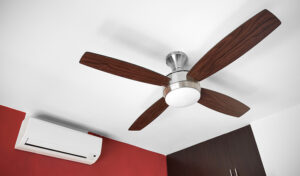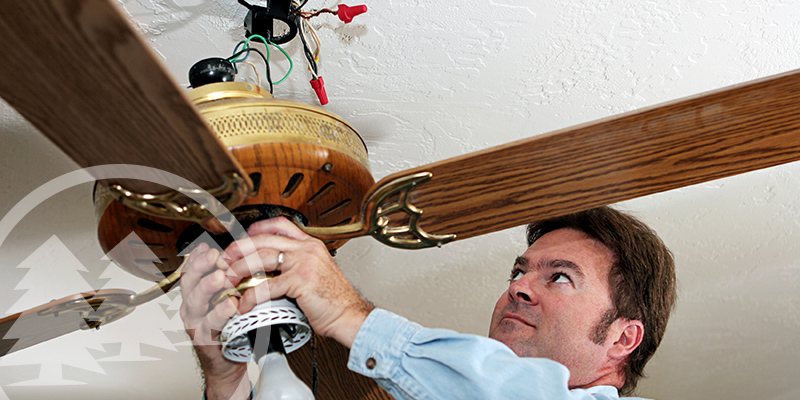If you have a ceiling fan in your home or apartment, then you are probably aware of the ceiling fan direction myth. According to popular belief, the direction of a ceiling fan’s rotation can affect the temperature of a room. As such, many homeowners go out of their way to adjust their fan blades to either cool down or warm up their surroundings.
Does the Direction of a Ceiling Fan Matter?
While heaters and air conditioners have long existed, ceiling fans predate them. Electric ceiling fans only came around in 1882, but the first noted ceiling fan goes back to the 17th century in India. Today, ceiling fans are a low-cost way to circulate airflow in a room and aid air conditioners on extra hot days. Despite their low cost, the ceiling fan industry is booming, with a projected global market size of $12.5 billion by 2025.
Ceiling fans are a staple in the summer, especially if you want to save on utility bills. They don’t use a lot of electricity, and they can effectively relieve some of the heat you feel. Although it might seem counterintuitive, many people also turn on their ceiling fans in the winter.
According to the popular myth, changing the direction of ceiling fans in winter can heat a room. If a ceiling fan’s blades turn clockwise, it can raise the temperature and warm the room. Moreover, the myth states that changing the direction of ceiling fans in summer can also cool down the same room. Turning the blades counterclockwise can lower the temperature and make the room colder.
Debunking the Ceiling Fan Direction Myth
 In the past, ceiling fans mainly kept people cool on hot days. This is perhaps when the ceiling fan direction myth began. People assumed that the temperature of a room could be dictated according to how the ceiling fan rotated in which direction. Fan blades that run clockwise make the room warmer, while fan blades that run counterclockwise make the room cooler.
In the past, ceiling fans mainly kept people cool on hot days. This is perhaps when the ceiling fan direction myth began. People assumed that the temperature of a room could be dictated according to how the ceiling fan rotated in which direction. Fan blades that run clockwise make the room warmer, while fan blades that run counterclockwise make the room cooler.
Over time, this assumption probably gained traction and became a part of everyday beliefs. Older generations would pass down this “lesson” to younger generations, who would take the advice at face value without question.
But, is there really any truth to the ceiling fan direction myth?
First, it is essential to understand that ceiling fans don’t affect temperature. They can’t raise or lower temperatures, so they don’t cool down or warm up a room. Instead, ceiling fans can make you feel cooler by drying up moisture from your skin and bringing your body temperature down. This is thanks to the wind chill effect they create.
Because ceiling fans don’t change the temperature of a room, switching the direction of blade rotations technically can’t do the same. The air movement remains unchanged. However, the direction of blade rotations can change the direction of air circulation, making it feel like the airflow changes as well.
Who Is Perpetuating the Ceiling Fan Direction Myth?
There are a number of possible reasons why people continue to believe the myth behind ceiling fan directions. Misinformation is rampant, especially in today’s world, where the Internet and social media make it easy to spread claims without scientific evidence. Some people trust everything they read or hear.
Of course, some people genuinely believe that ceiling fan directions can change a room’s temperature. This may be due to personal experience, wherein they perceived a shift in temperature after changing the direction of the blade rotation.
And then, some manufacturers and retailers push this myth on consumers for no other reason than increasing sales. They claim that their products can cool down or warm up a room according to the direction of the ceiling fan rotation. Consumers who place great importance on functionality and value for money then allow themselves to give in to these sales pitches without question.
How Do Ceiling Fans Work?
Ceiling fans are encased in a motor housing. This motor housing consists of an electric motor that rotates the fan blades. Depending on the direction of the blades, the fan can create either a downward or upward airflow. This airflow contributes to the wind chill effect, making people feel cooler.
Even though ceiling fans can’t inherently change the temperature of a room, they can affect air distribution or airflow. Rotating a ceiling fan counterclockwise can make you feel cooler in the summer by pushing cooler air downward. In the same way, rotating a ceiling fan clockwise can make you feel warmer by distributing warm air near the ceiling.
While changing the direction of a ceiling fan’s rotation can affect air circulation, it is essential to understand that it does not change the overall temperature of a room. Therefore, you should not feel disappointed or surprised if this simple act does not create a significant impact.
Changing Ceiling Fan Direction With Air Conditioning
Air conditioners are widely used in the summer. Unlike ceiling fans, air conditioners can change a room’s temperature. However, that does not mean you can’t use ceiling fans in the summer, too.
Ceiling fans help with airflow, so using them with your cooling system can distribute cool air. As such, you can change the ceiling fan direction for summer with air conditioning to cool rooms more effectively. This, in turn, can make you more energy-efficient and lower your utility bills.
How to Change Ceiling Fan Direction
 There are two ways to change the direction of your ceiling fan’s rotation. The first is the manual method, which works on older models. To do this, look for the small switch on the fan motor housing. Then, simply flip the switch to change the direction of the blade rotation.
There are two ways to change the direction of your ceiling fan’s rotation. The first is the manual method, which works on older models. To do this, look for the small switch on the fan motor housing. Then, simply flip the switch to change the direction of the blade rotation.
For newer and more advanced models, you can control the direction of your ceiling fan with a remote. Even programmable fans change directions automatically according to the season you set.
Ceiling Fan Direction Myth Debunked!
When it comes down to it, changing the direction of your ceiling fan’s rotation does not change the temperature of a room. It does not inherently warm up or cool down a space. However, it does help during winter or summer by aiding airflow. Calibrate your expectations to ensure the optimal use of your ceiling fan and create a comfortable living environment for everyone.
Cedar Management Group offers expert HOA management services to homeowners associations and condominiums. Call us today at (877) 252-3327 or contact us online to learn more!
RELATED ARTICLES:
- Winter In Your HOA: How To Keep Pipes From Freezing?
- 7 Summer Projects For HOA To Get Started On
- 9 Extra Fun HOA Event Ideas For Spring And Summer






